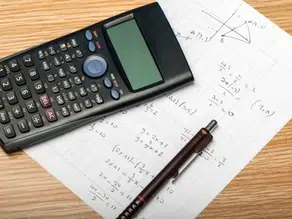Operations
One Variable
– Like terms: Terms whose variables (such as x or y) with any exponents (such as the 2 in x2) are the same. Examples: 7x and 2x are like terms because they are both “x”.
– REMINDER: Always check what they are asking for before selecting your answer. For example, the questions may ask “what is x + 4” as opposed to just “what is x”.
Two or More Variables
– 3 Quadratic Identities (unfactored to factored form)
(x2-y2)=(x+y)(x-y)
x2+2xy+y2=(x+y)2
x2-2xy+y2=(x-y)2
Variables in Choice
System of Equations
METHOD 1: Substitution
2x + 4y = 6 AND y = 5 —–> 2x + 4(5) = 6
METHOD 2: Elimination
2x + 4y = 6
Subtract these two equations to eliminate the “x”:
2x – y = – 9
5 y = 15
y = 3
METHOD 3: Set Equal
y = 2x + 3 AND y = 4x + 1 ——> 2x + 3 = 4x + 1
Absolute Value
Break the equation into two equations (positive and negative)
Absolute Value Equations will always have two answers!
| 2x + 4 | = 6
2x + 4 = + 6 2x + 4 = – 6
2x = 2 2x = – 10
x = 1 x = -5
Inequalities
– Pretend the inequality sign is an equal sign and solve for the variable!
– When you divide or multiply by a negative, FLIP THE SIGN!
-6x – 9 > 3
Add 9
-6x > 12
Divide by -6 AND flip the sign
x < -2
Exponents

Functions
– The “x” is Just a Place-Holder! It is just there to show us where the input goes and what happens to it. It could be anything!

Sequences
– Sequences are all about finding the pattern!
Quadratics
ax^2 + bx + c = 0
METHOD 1: Factoring
– Find two numbers that multiply to the last term and add to the middle term
METHOD 2: Quadratic Formula

The Discriminant
– The discriminant is everything under the radical in the quadratic equation = b^2 – 4ac
– If the discriminant is POSITIVE, then there are 2 real roots (“roots” is another word for “solutions” when equations are written in ax^2+by+c = 0 form).
– If the discriminant is ZERO, then there is 1 real root.
– If the discriminant is NEGATIVE, then there are no real roots. (#13 C Test 6)
– Know how to complete the square
Defined Operations
Imaginary Numbers

– Binomial addition involving constants and i by combining like terms (adding and subtracting complex numbers)
– Multiplying by the conjugate of the denominator with complex numbers (#11 Test 2)
Number Theory
– Integers: whole numbers, including zero and negative whole numbers
– Prime Numbers: positive integers that are only divisible by themselves and the number 1 2,3,5,7,11,13,17,19,23,29,31,37,41,43,47,53, etc…
Divisibility & Remainders
– Polynomial Remainder Theorem (#29 C Test 1) (#7 NC Test 3)
– Divisible by 2 = last digit 0, 2, 4, 6, 8?
– Divisible by 3 = sum of digits divisible by 3?
– Divisible by 4 = last 2 digits divisible by 4?
– Divisible by 5 = last digit 0 or 5?
– Divisible by 6 = follow rule 2 and 3?
– Divisible by 8 = last three digits divisible by 8?
– Divisible by 9 = sum of the digits divisible by 9?
– Divisible by 10 = last digit 0?
Ratio & Proportions
– Direct and Indirect Proportion (a1/b1)=(a2/b2) and (a1a2 = b1b2), respectively
Percents
– Percentage = (Part/Whole)
– Percent Change = (Difference/Original) x 100)
Triangles
– Special Triangles (3/4/5, 5/12/13, 30/60/90, 45/45/90)
– Pythagorean theorem is used to find the third side of a right triangle. It is ONLY for right triangles. NOTE: Hypotenuse is always the longest side.
– The largest side is opposite the largest angle. The smallest side is opposite the smallest angle.
– All three angles add up to 180 degrees!
– The sides of similar triangles all have the same respective proportions. (#17 NC Test 1, #18 NC Test 2)
– The Third Side Rule for Triangles (a-b) < c < (a+b) if c represents the “third side” and b and a represent the lengths of the other two sides.
– The proportion of distance that you travel along the hypotenuse of a right triangle is equal to the proportion of distance that you travel along both legs. (#16 NC Test 4)
Circles & Sectors
– The Circle Proportionality Formula (Slice/Area = Arc/Circumference = Measure of Inner Angle/360)
– The arc measure formed by an angle with its vertex on a circle is double the measure of the angle. (#36 C Test 5)
– The equation of a circle with center (h,k) and radius r: (x-h)2 + (y-k)2= r2 (#24 C Test 1)
2D & 3D Objects
Surface Area of a Cube = 6s2
Area of a triangle = 1/2 ab sin C
– Unfortunately all the formulas below are not included on the ACT, unlike on the SAT.
– The vertex of a parabola is located at the midpoint of its x-intercepts (#12 NC Test 3)
– The vertex (h,k) form of a parabola: a(x-h)^2 + k
– When an upward projectile reaches its highest point, its velocity is zero.
– When an upward projectile lands, its height is zero.
– To find the intersections of two lines, set them equal to one another (#13 test 4)
– In a system of linear equations, there is no solution if the slopes of the two lines are the same (parallel) and the y-intercept is different. (see #9 Test 3) Conversely, there are infinitely many solutions is the slopes of the two lines are the same and the y-intercept is also the same (#20 NC Test 2)
– The “zeroes” or “roots” of a function are the x-coordinates where it crosses the x-axis (and where the y value outputs zero).
– A polynomial of Nth degree has at most N-1 changes in direction.
– Domain and Range
– Parallel Lines and Transversals (#36 Test 1)
– The Formula for a Line (standard y=mx+b format as well as point-slope format: y-y1 = m(x-x1), and the slope equation (y2-y1) / (x2-x1) ).
– Positive and Negative Associations in Graphs (#5 C Test #1)
Number Lines & Line Segments
A line extends forever in both directions.
A line segment has two endpoints.
A ray is a part of a line that has one endpoint and goes on infinitely in only one direction.
A midpoint is the middle of the line. To solve for the midpoint, take the average of the x value and the average of the y value.
Angles
A line measures 180degrees.
Types of angles to know:
– opposite angles
– supplementary angles
– opposite interior angles
– complimentary angles
Degrees & Radians
– π radians = 180 degrees (#19 NC Test 2)
Probability
Probability = (Desired Possibilities / Total Possibilities)
Permutations & Combinations
Permutation = arranging the objects or numbers in order
Combinations = selecting objects or numbers from a group, in which order doesn’t matter.
Simple & Compound Interest
Simple interest is based on the principal amount of a loan or deposit. In contrast, compound interest is based on the principal amount and the interest that accumulates on it in every period.
Rates & Work
Distance = Rate x Time (#38 C Test 5, #9 C Test 3)
Mean, Median, & Mode
Mean: average = (Total / Number of things)
Median: middle number
Mode: most frequent number
Concept: Weighted Averages (#19 NC Test 5)
Standard Deviation & Range
Tables & Charts
– Box and whisker plots (showed up on March 2018 SAT)
Matrices
Scientific Notation
– Negative exponents move the decimal to the left.
– Positive exponents move the decimal to the right.
Word Problems
– Word problems can come in the form of any topic above. The best trick is to convert the words into a mathematical equation first!
Other Helpful Study Materials

Samantha is the co-founder and COO of Prep For Success Tutors! She has been tutoring the ACT for over 10 years and is passionate about helping her students. Never hesitate to reach out to her to get support on the ACT.
Prep For Success has a team of amazing ACT tutors, who have all scored in the 99th percentile. Additionally, all of them have been rigorously trained on all of our tips, tricks, and strategies to obtain a high score! Each tutor takes the time to understand your specific strengths and weaknesses so you don’t waste time in your studies and have the most effective study plan! Feel free to reach out to get assistance on the ACT or College Admissions.





